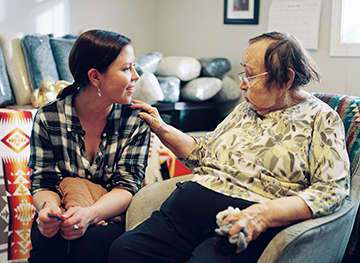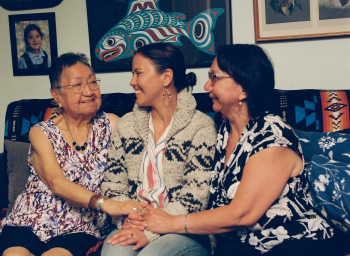Image Caption
Summary
Local Journalism Initiative Reporter
Windspeaker.com
Award-winning writer and director Mary Galloway has partnered with A Knitted Legacy Films Inc. to document the tradition of knitting Cowichan sweaters.
Cowichan Sweater, Our Knitted Legacy will premiere on CBC GEM on Oct. 6 and will broadcast on CBC TV across British Columbia and Alberta on Oct. 7.
“The Cowichan sweater is a knitted garment that is made of raw sheep’s wool and knitted into a sweater in different patterns, depending on which knitter has made it,” said Galloway.
“They’ve been a part of our culture and our history for over one hundred years. They are really beautiful hand-knit sweaters, but a lot of people don’t know what they are and where they come from, so this documentary will teach people about them.”
The film explores the history of the sweaters in the Cowichan and Saanich territories on Vancouver Island and the traditional knitters from these communities.
Several of the all-Indigenous crew had ancestral ties to the communities, but Galloway had a special journey she was also taking during the filming.
Her late grandfather, Chief Dennis Alphonse, often wore a Cowichan sweater.
“This is a really personal story too, because I have a lot of photographs of my late grandfather,” she said. “He was on chief and council for over 40 years in our nation, and a lot of the photos I have he’s wearing this Cowichan sweater.”
The 33-year-old Indigenous filmmaker and the crew spent 15 days interviewing members from the communities, some of which are still spinning wool and knitting these garments today.
“We’ve always been weavers in the Salish territory, and it evolved into knitting,” said Galloway.
“This documentary will teach people about (the weavers) and about this history of the sweaters.. They each are very unique and no two sweaters are alike, and that’s the beauty of them. They’re genuinely works of art,” Galloway said.
“They’re such a master craft that these knitters have been able to perfect over the years and pass on from generation to generation. They keep you warm and they will last for 100 years if you take care of them.”
In total, the crew was able to interview 20 community expert knitters.

Producer Tiffany Joseph, who also originates from the area, explained how the crew were welcomed into each of the community members' homes.
“We were able to enter these homes and it felt like... it felt like family,” said Joseph. “It was a really beautiful, enjoyable experience working with all Indigenous people to truly do this film in the right way… and I really feel like the right people came together to be able to do this work in our community.”
During their time in the community, the crew had invited members to come out to what they called “Cowichan Sweater Day” and were asked to wear all of their knitted clothing.
“People came with Cowichan sweaters and vests and headbands,” said Joseph. “There was a person who wore Cowichan knitting from head to feet. He had a toque, a sweater, a bag. He had slippers. There was a whole family who had matching sweaters. They didn’t just have the traditional, original wool colours of the sheep, but they also had a blue wool that they all had matching. It was so beautiful seeing over a dozen people wearing a matching sweater.”
During that time, Galloway was also able to find the knitter who made her grandfather’s sweater.
“During the process of making this documentary, I was able to go on a journey to find the knitter who has the pattern of his sweater, and they were able to recreate for me a sweater in his honour,” she said, adding how grateful she was for this meeting.
Joseph also had a personal reason for working on the show. Her grandmother, who passed away at 92, was a knitter.
“She was a knitter, and that’s how she provided for 15 children when the colonial society wouldn’t buy fish from my grandpa, who was a fisherman. That’s why I became a part of this project,” Joseph said.
During the time of colonial settlement there was also a transition in the type of wool that was used, Joseph explained.
Originally the sweaters were made with hand-spun mountain goat wool and “woolly dog hair.” The two types of fur were blended together and weaved into blankets.
When Europeans settled, they brought in sheep and knitting needles and the craft changed from weaving to knitting.
“So, we stopped using the mountain goat hair and the Salish woolly dog hair for various reasons, which are, you know, of course, have harm behind it,” said Joseph.
But even though the wool changed, knitters continued to only use natural wool colours—black, grey and white.
There used to be a wool mill in the area, which encouraged more knitters because the fabric was more accessible, Joseph said. But over the years the mill was shut down.
She recalls when she was around 20 years old and learning how to knit she had completed her first project, a scarf.
When she was done she asked her teacher if she could make another scarf and “she was like ‘oh, actually we ran out of wool and we can’t get anymore’.”
“I was really sad and disappointed, so you know, that really strongly impacts our community as to why we struggle to continue knitting because we have a limited access to wool,” Joseph said.
“I feel this part of our culture is being lost quite a bit, especially with the rising prices of wool and the inability to access wool easily,” said Galloway.
“It’s such a world-renowned practice that it’s become at risk of extinction, but also for appropriation. So, there’s a lot of clothing giants, fast fashion type companies, that have knocked off the sweaters and it’s really harmed our community.”
She hopes by sharing the history of these sweaters it will encourage consumers to support the tradition and the expert knitters who make them.
“This documentary, I hope, making it will help people to understand the importance of buying authentic Cowichan sweaters and to hopefully reinvigorate the industry to keep it going,” Galloway said.
“It’s a practice that has been dying out for quite a while, but hopefully this documentary will help bring more excitement back into the community and have our youth get more interest in creating the sweaters and making them learn the practice.”
Local Journalism Initiative Reporters are supported by a financial contribution made by the Government of Canada.

